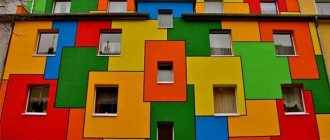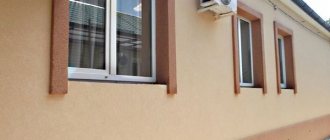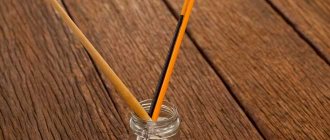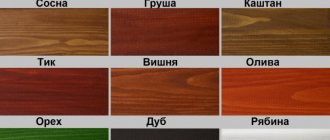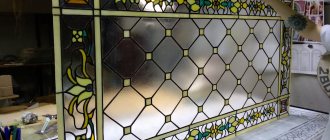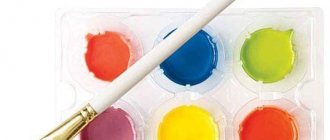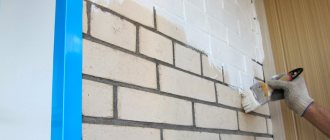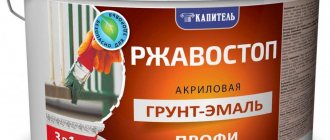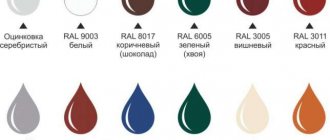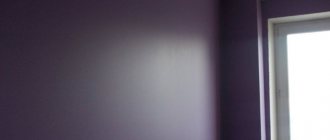One of the trending solutions for decorating a room is painting a brick wall. The result is a loft design that satisfies a modern minimalist interior solution where any furniture will fit. But in order for a painted wall to retain its appearance for a long time, it is necessary to adhere to certain rules.
It will be impossible to restore the original appearance of the painted wall of the house; it is impossible to remove the applied coating from the brick; in the future, only repainting is possible. Moreover, the layer will last no more than five years. And as a natural material, brick will ooze efflorescence and moisture, which over time will spoil the appearance of the finish. In any case, the operation must be approached with due responsibility, since incorrectly done work with your own hands will give the walls the appearance of a cheap craft.
All the shortcomings of this type of finishing are compensated by the fact that wall defects will become invisible, the interior or facade solution will correspond to the design of the project and be combined with any furnishing elements or buildings. You can paint a brick wall indoors or outdoors creating a trendy and modern style.
Technology for painting brick walls outside
Silicate, silicone, mineral-based water-dispenser paints or latex or acrylic-based paints.
All of them will not give the expected result if you do not follow the dyeing technology and some recommendations. Painting a brick wall with facade paint can be done using a paint brush, roller, sponge, or spray gun. Painting a brick wall with facade paint can be done using a paint brush, roller, sponge, or spray gun.
How to prepare a brick facade for painting
The service life of the finishing coating depends not only on the quality of the paintwork material, but also on how well the surface was prepared. Preparation includes several stages:
- The walls are cleaned of dirt. The seams are inspected and the old mortar that has lost its structure is removed. The resulting depressions are sealed with new cement mortar or a special sealant. Cracks are treated in a similar way. After finishing and completely drying the sealant, you need to walk over the surface with sandpaper to remove all irregularities.
- Salt stains, visible and invisible, are treated with a brush with stiff bristles and a solution of lime and water (ratio 1 to 3). You should not skip this stage, since the decorative coating will only temporarily mask the efflorescence.
- Antiseptics will help get rid of mold and mildew. After 20 minutes, its remnants are removed with a brush. If there are oil (greasy) stains on the surface, they are treated with a degreaser.
The service life of the finishing coating depends not only on the quality of the paintwork material, but also on how well the surface was prepared.
How to properly apply paint to brick
Painting with a brush is the highest quality method, which requires painstaking work and takes a lot of time. The brush is used in horizontal movements, following the masonry line. Depending on the type of paintwork, the appropriate brush is selected. For example, a brush with polyester fibers is suitable for acrylic mixtures, and natural bristles for alkyd compositions. The optimal brush width is 10 centimeters. To paint the corners, use a device of smaller width, and it is advisable to cut the pile obliquely.
Craftsmen advise using a roller to apply the initial layer, as it speeds up the process, and the brick, having good porosity, quickly absorbs the composition. It is advisable to choose a roller with medium-length pile. A spray gun will help to treat a large area in a short time. When painting, it should be positioned at the same distance from each area. This way the paint layer will be even. However, the device itself is expensive, and paint consumption increases several times.
Painting with a brush is the highest quality method, which requires painstaking work and takes a lot of time.
General Tips
You will have to paint in at least two layers. If the paint is light in color, then two coats may not be enough. Buy paint based on the number of layers.
We recommend using a primer. It greatly increases the adhesion of compounds and reduces material consumption. The cost of primer is significantly cheaper than paint, which increases the economic efficiency of its use.
Apply primer to the wall before painting
When choosing rollers, give preference to soft options. Hard ones leave a lot of gaps on uneven surfaces.
Cover the junctions of brick walls or elements with other structures with masking tape. If you have some practical skills, do not glue anything, but at the joints, finish the remaining unpainted surfaces with a brush. If you work carefully, the junction line will be smooth, you won’t have to correct or clean anything.
Painting a brick wall
Painted brick facade
Peculiarities
Today, a number of materials for exterior finishing work are available on sale.
Modern paint and varnish products have a number of the following properties:
- complete absence of chemically harmful substances in the composition;
- resistance to mechanical stress and sunlight);
- elasticity of the coating after painting;
- high moisture resistance;
- compatibility with other paints;
- wear resistance;
- very easy to clean from dirt;
- vapor permeability.
Sand-lime brick paint is suitable for painting both a new house and old buildings. It is easy to apply, does not form streaks, and does not splash. It is much cheaper in cost than other materials and is more accessible to a wide range of consumers.
In general, brick, according to its characteristics, is a material that is completely ready for long-term use while maintaining its original appearance. However, the building will look familiar and of the same type. The colors will give it a completely new, sometimes fabulous appearance.
The main types of paint and varnish coatings for bricks are acrylic, silicone, silicate, and enamel paints. They come in glossy, semi-matte and matte. Each has its own reflective ability (complete absence in matte, greatest in glossy).
Acrylic coatings are highly resistant to temperature changes; their service life is 8-11 years. Facade painted walls are not subject to cracks and are easy to clean. The paint does not crumble under the influence of rain and sun. Acrylic resin is added as a component, so moisture is poorly absorbed.
In most cases, it is not recommended to apply coatings to a newly constructed façade. This rule does not apply to acrylic paints, since they contain a binder material that stops the alkali corrosion present in the fresh solution. Therefore, within 30 days after the construction of the building, it can be painted in any color.
Silicone paints and varnishes are durable and dry quickly (- 3 hours after painting). The siloxane (resin-based) solution contained in their composition protects against mold and mildew. In regions with hot climates and high air temperatures, painted facades do not change their appearance when exposed to ultraviolet rays.
Contaminants in the form of dust on covered buildings are very quickly removed naturally (by precipitation). A painted house can last 18-20 years before the next renovation. Various tinting agents are used to change the color of the paint. The main color is white. You can convert it to any.
Silicate paints are susceptible to changes in air temperature. They tolerate moisture well, have high vapor permeability and fire resistance. Apply in two steps. The first layer dries in 24 hours. The second one is in 8-11 hours.
Enamel coatings are fire hazardous and toxic. They contain varnish. However, these paints are very moisture resistant, durable and corrosion resistant. Drying period – 6-20 hours.
A special mineral paint for bricks has been created based on cement. It is intended for previously painted facades that are difficult to restore. The degree of water resistance and vapor permeability of this paint and varnish material is very high. The color of a brick house will not change for 10 years after treating the walls with this paint.
Oil paints are used much less frequently. Most often they are used to paint Russian stoves installed in summer kitchens (temporary buildings). It is very convenient to apply beautiful artistic ornaments and designs using this paint and varnish material.
The best option for painting are multi-colored latex acrylic paints (Belinka, Sicily, Acrylatil, Husky, Mikrel and others). Each of them has its own unique characteristics.
Sicily paint is a silicone-modified, alkali-resistant, self-cleaning material. Used for facades of houses located in dusty areas.
General requirements for paint for external work
The outer walls of a building often deteriorate due to rain (especially if there are no drainage systems, no canopy or leaky frames), ultraviolet radiation, and steam escape (insulation problems).
Poor exterior finishing “wets” the brick, causing it to begin to collapse. Before buying paint, you need to find out the reason for the destruction of the walls.
You need to adhere to some rules - not every paint is suitable for chimneys.
The choice of paint largely depends on environmental conditions.
To restore and protect a brick wall, you can choose a moisture-resistant paint and an additional water repellent - a solution with organosilicon compounds that is added to water or a solvent (also suitable for concrete).
The solution will prevent moisture from being absorbed into the brick.
Note: one of the main reasons for the destruction of brick is its poor quality.
How to choose the right paint for exterior decoration: basic criteria
If the external walls are covered with salt deposits, then choose facade paint for external work on bricks that is as resistant to alkalis as possible (latex paint forms a protective film through which salt cannot penetrate).
White coating on surfaces cannot always be seen - in some cases it can be completely transparent. A pronounced coating of salt is called efflorescence - the more alkali there is, the more it is released on the surface of the walls.
There is always alkali, but in different percentages.
Ultraviolet radiation and weather conditions
Over time, under the influence of sunlight, the wall begins to fade. On one side the brick can be a dark shade, and on the other it can be light. To avoid such differences, use paint that protects the coating from fading.
Brick paint for exterior use must be resistant to temperature changes and not allow moisture and snow to penetrate into the seams between the bricks.
Paint and varnish compositions must have good vapor permeability - this means that after drying, the paint must allow air to pass through (especially for rooms where interior decoration was carried out).
It is important that the wall “breathes”, then the masonry will be more stable. Do not forget about the description of the characteristics on the can - along with the list of composition, the paint consumption per 1 m2 is indicated on the tube
Do not forget about the description of the characteristics on the can - along with the listing of the composition, the paint consumption per 1 m2 is indicated on the tube.
The less specified, the more economically the material will be used. Each jar indicates a different value. In the description you can find out the time when you need to update the facade.
An important factor when choosing paint is high susceptibility to mechanical damage.
Paint is especially sensitive to abrasive dust - powder obtained as a result of grinding or polishing surfaces. The material that is “ground” loses particles, dissipates, which means the paint may peel off.
The color of paint for bricks for exterior use can be any, the main thing is to choose waterproof compositions with protection against fading.
As for indoor walls, ultraviolet radiation does not have such a strong effect on indoor walls.
Do not forget about adhesion - the better the adhesion of the surfaces of dissimilar solid or liquid bodies in the paint, the longer the service life of the brick (good adhesion should be not only with the brick, but also with the cement mortar).
If adhesion is at the highest level, then the solution can be applied to the walls without prior priming, and this is a plus.
When the wall surface is heated, the paint must be plastic and compensate for the thermal expansion of the walls.
Another important quality is ease of application and speed of drying (it is not recommended to use quick-drying paint). The shelf life of paints and varnishes depends on the composition and its manufacturer.
Maximum term – no more than 9-10 years
The shelf life of paint materials depends on the composition and its manufacturer. The maximum period is no more than 9-10 years.
After this period of time, the external façade will have to be renewed again.
Tools for painting a brick wall
Before painting bricks, you need to choose the right tool for the job. The master will need:
- Brushes. They are selected according to the material used: for acrylic - polyester fibers, for oil products - natural hair. The width of the tool ranges from 7.5-10 cm. For painting corners, a product with a beveled edge is used.
- Roller. It is better to give preference to models with a pile whose length is 2 cm. It is simple to work with, but the quality of applying the composition will be slightly worse than with a brush.
- Cascopult. It is used when it is necessary to decorate large surfaces. To work with the tool, you need protective equipment and clothing.
You may also need containers for diluting paint, roller trays, solvents, gloves and other materials.
What to consider
Many people wonder whether it is possible to paint brick, and the answer is simple. If you do it correctly and use quality materials, then it can be done without problems.
But it is worth understanding the following:
Once you start work there is no turning back
This process is practically irreversible. If you start doing the work, then you won’t be able to return everything to its original place. Even if the wall is made of M100 or M75 brick, the gloss on the side edges cannot be restored.
Difficulties in painting
Brick is made from natural materials. If it is not settled, then there are certain difficulties. After all, the surface is porous and absorbs moisture. Therefore, painting old or used bricks is much easier. Here the material is already established.
Quality of plane preparation
The durability of the coating will mainly depend on this parameter. There must be high-quality adhesion of surfaces and we need to work on this.
Types of dyes
This material is sufficient in retail chains. And how you can paint a brick must be decided depending on the environment. There are two options here and we will talk about them below.
Attention: Fresh brick does not paint better. It is better to do this when the material has leached
Then you will spend less dye and it will not be such a labor-intensive job. So before making masonry, think about whether it might be better to make it with facing material or apply plaster.
Preparing a brick wall for painting
Painting brick walls on a balcony or inside a house is not difficult, but you need to thoroughly prepare for the work. To achieve a good final result, the following types of work should be carried out:
- Cleaning the walls. To do this, use a brush with metal teeth and detergent. If there are stains of old paint or whitewash on the surface, they must be treated with a solvent. Soap and dirt can be washed off with plain water. After the procedure, you need to wait at least a week for the absorbed liquid to come out of the brick.
- Elimination of efflorescence. A stiff brush is also used to remove salt. But after this you will have to paint the brickwork in 2-3 days. If the salt appears repeatedly, then it is better to treat the surface with a special composition that contains acid, or ammonia.
- Repairing chips and cracks. Large damages should be filled with cement mortar. The cracks are first cleaned of dust. After treating the wall, you can decorate it after 10 days.
- Surface primer. It will help improve the adhesion of paint to the surface, ensure the durability of the coating, and reduce the consumption of finishing material. The primer needs to be applied in several layers.
You can paint brick walls yourself if you follow the work technology.
Important points
At first glance, the technology is simple, but compliance with certain conditions will help save time and money:
- completely rinse and remove efflorescence from the wall surface;
- remove the previous coating with a scraper, subsequently cleaning with sandpaper;
- After washing or applying a coat of paint, let the wall dry completely;
- Be sure to apply a primer, the financial costs will increase, but they will pay off in the durability and quality of the coating.
How to choose a brick coating
Paint and varnish materials for stone-like bases must meet certain requirements.
Material properties
- The best facade paint for brick is one that is vapor permeable. The coating should not interfere with the normal diffusion of water vapor from the walls.
- Another necessary parameter is the moisture resistance of the finish. In other words, the reliability of the protection it provides from precipitation.
Service life of different types of coloring compounds.
An important factor is the durability of the coating.
It must serve for a minimum of five years.
It is worth paying attention to the alkaline resistance of the material. Almost all masonry mixtures for bricks contain alkali
It “burns through” the incorrectly selected coating, which leads to its destruction.
The dye consumption determines its volume sufficient to process 1 m2. The lower this indicator, the more modest the price of the work. However, their quality should not suffer.
The speed of complete drying differs for different types of compositions. In addition, it depends on the temperature of the base and the operating environment. Material that dries too quickly will not be very comfortable.
Adhesion determines the ability of a coating to adhere to a substrate. This value is very important. Especially if you are not going to prime the facade.
Article on the topic:
Exterior Brick Paint
Paint composition
The photo shows acrylic paint with latex added.
Nowadays mineral paints for bricks are quite popular. The basis of the composition is cement. The material has good vapor permeability and water resistance. It is usually applied with a brush.
Many professionals believe that the best choice for a brick facade is acrylic compounds with the addition of latex.
They have a high level of steam permeability. An important advantage of such compositions is resistance to alkali. High-quality acrylic paints and varnishes can be used to cover newly built brick facades. This can be done 30/45 days after laying.
Efflorescence spoils the appearance of a brick wall; paint will protect against it.
- This type of composition forms a durable film on the brick. It rids walls of salt stains (efflorescence), which spoil the appearance of the wall decoration.
Coloring compositions based on polyvinyl acetate are also used for painting bricks. But they have a low level of resistance to moisture. Therefore, the instructions advise using them in dry climates.
For bricks that are difficult to paint, there is a special processing method. When applying a base coat to such a surface, you should mix the silicone primer with paint on the same base. This composition will adhere well to the base and will not fade for 8/10 years.
Heat-resistant varnishes for bricks
Brick is often used when laying stoves; such structures require special heat-resistant varnishes. They must have the properties described below:
- Withstand high temperatures above 200-250 degrees;
- Resistance to water, so that mold and fungal formations do not appear over time;
- High level of adhesion, the composition must penetrate deeply into the material for high-quality protection;
- The presence of acrylic in the varnish so that drying takes less;
- Absolute colorlessness, then the decorative property will be good.
The following brands of similar varnishes are distinguished: KO85, KO815, Siltek-1.
Brick is often used when laying stoves; such structures require special heat-resistant varnishes.
How to Paint a Brick House Outside - Types of Paint, Instructions, Mason Tips
Creating beauty inside and outside your home is the natural desire of every home owner. Painting a brick house protects against adverse weather conditions and at the same time creates an attractive appearance. The availability of paint on a brick facade provides an opportunity to update the appearance of a building without excessive costs. It is worth taking a responsible approach to the choice of paint and varnish coating, then the neat appearance of the external walls will remain for 5 years. This effect is achieved only by maintaining the paint application technology, not forgetting about the necessary preparation.
It is not recommended to paint fresh brickwork, since drying, weathering of the material and leaching are completed only after 6 months.
Varnish manufacturers
There are many varnishes available on the construction market that are suitable for processing brick. For this reason, it is difficult for beginners to make a choice; then you can focus on popular manufacturers:
- Pufas, the varnish of this brand adds a beautiful shine to the material, creating reliable protection against water;
- Petri, a popular polyurethane varnish that is resistant to abrasion and dirt, increasing the service life of the brick;
- Neomid, with a matte effect, does not emit an unpleasant odor, can be used inside a building, creating protection from water and biological formations;
- KrasKo produces several high-quality varnishes for brickwork.
Can be used inside a building, creating protection against water and biological formations.
Varnishes for brick surfaces are used to increase the durability of the material. There are several types of varnishes that can create a film coating that qualitatively protects the base from moisture, ultraviolet radiation, temperature changes and other influences, while maintaining the appearance of the brick unchanged. You can get a matte, semi-matte or glossy finish, improving the decorative properties.
Preparing for painting
If the building was built a long time ago, then white salt stains may form on the surface of the walls. Manufacturers of latex paints have developed binders that can form a film that prevents such deposits from appearing on brick walls. To prevent the process of accumulation of white deposits, you should find the causes of their occurrence.
It is necessary to carefully check the surfaces for the presence of condensation, using sealant (cement) to eliminate places where there is penetration of moisture from the outside. All cracks and irregularities must be sealed. Next comes the plastering process, after which the façade walls are given time to dry. Then processing is carried out (grouting and smoothing the seams) with a wire brush.
The primer can be purchased ready-made or made independently.
Ready-made ones come in the following types:
- Acrylic - best suited for latex paint.
- Silicate – has good breathability. Resistant to precipitation.
- Epoxy – provides surface waterproofing and adhesion.
To make your own solution for priming brick walls, you need to take the following components:
- copper sulfate -1 part;
- laundry soap - 2 parts;
- wood glue (bone) -5 parts.
Then take a bucket of water and bring it to a boil. Grind the laundry soap by rubbing it on a kitchen grater. Pour the resulting soap crumbs into boiling water, stirring until dissolved. Wood glue and vitriol are added to the solution.
After this, reduce the heat and leave the mixture to simmer for half an hour. After the time has passed, remove the container with the mixture from the heat, cool slightly and filter (while warm) through a sieve. The solution is ready. Apply like any primer with a brush, roller or special painting equipment.
The entire preparatory process ends here.
Application technology
The work is not difficult, although you will have to try to make the painted brick look presentable. Many people believe that they paint bricks solely to form a protective layer. This is an erroneous opinion, since first of all it is necessary to try to translate design ideas into reality and make the walls attractive.
The first layer of paint is applied liquid, for which the material is diluted with a solvent. After this, the main covering layer is applied, for which a spray gun, roller or wide brush is used. Work begins from the top section with a gradual shift downwards.
Treatment of facade walls is carried out in warm weather, when the temperature is twenty to twenty-five degrees.
Choosing paint for a brick surface
Before you paint a red brick wall a different color, you need to choose the optimal composition. The choice depends on several factors:
- external or internal wall;
- coating requirements;
- quality of masonry.
In order for the coating to look harmonious and not peel off, the paint and varnish products must meet certain requirements:
- vapor permeability - artificial stone has pores that provide air exchange, the coating should not form a film on external walls that worsens the microclimate in the room;
- UV resistance - color should not fade;
- water resistance – protects the surface from precipitation;
- high adhesion - this property guarantees uniform painting of red brick in white without peeling during operation.
The coating for facades must be frost-resistant. Optimal compositions for external work are acrylic, latex and silicate paints. The first 2 options are made on the basis of synthetic resins. They protect the masonry from moisture, are characterized by low consumption and a variety of colors. Silicate compositions based on liquid glass are durable, waterproof and vapor permeable.
Important subtleties
Let us note a few essential details that will help paint brick walls with high quality:
- when finishing exterior decoration, it is important to work under the conditions specified by the manufacturer - temperature, absence of wind, precipitation, direct sun;
- in the premises it is necessary to use high-quality, uniform lighting - a lamp with a lampshade is attached so that the light comes parallel to the wall;
- Angled brushes are used to paint corners.
When painting with a roller, make sure that it is evenly saturated with the dye - this will avoid streaks and unevenness.
Brick paint for exterior use - when to paint
Brick, like any other material, loses its presentability over time. The surface becomes dirty, loses its color, and whitish salt spots appear. Correctly selected paintwork materials will help correct these shortcomings. The main thing is to choose the appropriate color and texture of the composition.
Painting the exterior of the brick facade of a house is necessary to give it a presentable look and solve several problems. For example:
- When brick loses its appeal. Molded parts, moss, and so on appear on it. Using paint you can not only improve the appearance, but also provide protection from further destruction of the building material;
- Over time, salt appears on the bricks. It appears due to the use of low-quality material containing clay with a large amount of salts. Removing these white spots from the walls is quite simple, but it is more difficult to eliminate the problem as a whole, therefore you cannot do without painting;
- Brick paints of a wide variety of colors will help give the exterior exclusivity and novelty.
It is necessary to paint a brick facade when the building has been standing for at least a year.
Requirements for paintwork materials for brick bases
Removing paint and varnish from brick is a labor-intensive, costly process that requires special equipment, since it is not possible to manually remove the paint layer. Therefore, when purchasing paints and varnishes, you should adhere to a number of requirements.
- The coating must have good adhesion to the surface. This indicator determines how tightly the coating will adhere to fluctuations in temperature and humidity.
- The composition must “breathe”. This is especially true when the inside is painted. In the absence of this parameter, pathogenic microorganisms will appear in the material over time.
- Resistant to fading. Its absence will lead to the fact that the facade of the house will quickly lose its attractiveness.
- It is desirable that the composition be used economically. However, this depends on the type of paint.
- Hardening period. Considering that facing bricks are being painted, you need to remember the surprises of nature. For example, the weather may turn bad and it may rain. Then the paint will simply drain from the surface.
- Painting not only performs a protective function, but also serves as a decorative element. Therefore, façade paints should be simple and easy to maintain, so that if they become dirty, they can be easily cleaned up.
- It is desirable that the main color can be diluted with colors.
- Most private houses are equipped with a chimney or fireplace, so the finishing material must be heat-resistant.
- High performance characteristics - they affect the strength of the coating under negative environmental influences.
Paintwork materials come with a glossy or matte finish. When purchasing, you need to remember that if there are errors, it is better to use glossy compounds. Matte ones look great on flat surfaces.
When purchasing, you need to remember that if there are errors, it is better to use glossy compounds.
No. 3. Russian or foreign, which brand is better?
On the shelves in construction stores you can find many paints and varnishes with the same characteristics, but from different manufacturers. How can you not fall for the flashy label and buy truly effective formulations?
Pufas
This company ranks first in the ranking of the best paints and varnishes. This is a German manufacturer, which is one of the oldest concerns in the global paint and varnish production market. The company's product range includes more than two hundred types of finishing compounds for working with various materials. The company's products are successfully supplied to Russia and Ukraine. Pufas varnishes dry quickly, have no strong odors, and are easy to apply. They are distinguished by high quality standards and corresponding prices.
Petri
This is an American manufacturer whose products have proven themselves positively among domestic buyers. The line of coatings with the “wet stone” effect for brick bases is especially in demand. Petri impregnations prevent contamination, destruction of substrates and mechanical wear. They are also odorless and dry quickly.
Neomid
In the Russian market of paints and varnishes, the Neomid Stone company has gained the greatest popularity. It produces high-quality impregnations and varnishes that do not contain a dangerous toxic odor. These products can be used in small spaces without any problems. Neomid varnishes are also characterized by the following qualities:
- Form style. The company offers matte and semi-gloss finishes while others offer gloss and semi-gloss options.
- Reliability. The manufacturer has taken care of an increased level of protection against moisture.
- Antifungal impregnation. The varnish creates a dense protective film that prevents the possibility of fungus formation.
“Chief Technologist”
This is a Russian manufacturer that specializes in the development of heat-resistant compounds for fireplaces, stoves, and furnaces. The products of this company are made from foreign raw materials. “Chief Technologist” paint and varnish compositions dry quickly, but immediately after their application an unpleasant toxic odor is felt.
“KrasKo”
The company offers several variants of compositions for coating brick bases: “Protexil”, “Epoxol”, “Texil” and “Aquastone”. Production technologies are Russian, and raw materials are foreign. High-quality compositions of “KrasCo” have an affordable price, which makes them popular among domestic consumers.
Rustins (UK)
The most popular among the compositions offered by this company is the heat-resistant varnish Brick Varnish (matte). It can withstand temperatures up to +150, prevents the appearance of fungus, cracks, and does not lose color. But its cost is significantly higher than its Russian analogues.
Fireproof KO-85
This type of paint and varnish is designed specifically for stoves, fireplaces and fireboxes. It is suitable for working with metal, stone, ceramic, concrete, brick and even wooden substrates. Fireproof varnish does not support combustion and reliably protects against fire and destruction. It can be applied even at low temperatures. It dries quickly, and the pungent smell quickly disappears. When applying just one layer, the surface will be reliably protected from moisture and condensation.
Types of paint and varnish coatings
Let's look at the main types of wear-resistant brick paints intended for outdoor use.
Acrylic
Such compositions are characterized by good resistance to temperature changes and can be used for eight to eleven years. Walls painted with acrylic paint do not develop cracks and respond normally to wet cleaning. The covering layer does not crumble from exposure to sunlight and precipitation. The main component of the composition is a resin that does not absorb water well.
It is believed that newly erected brick walls should not be painted immediately, but this restriction does not apply to alkyd compositions. They contain a binder component that counteracts the alkali corrosion characteristic of fresh masonry mortar. So if a month has passed since the construction work, you can safely paint the walls with acrylic composition.
Silicone
Paints in this group have good durability and dry within three hours after application. The siloxane composition present in the material reliably protects the surface from the formation of fungal mold. When exposed to ultraviolet light, the paint does not change its original shade.
Silicate
Dust and dirt are removed naturally from a brick surface painted with this composition when precipitation occurs. A house painted with silicate paint will last for twenty years without requiring repairs. The main color of silicate group paints is considered to be white, but by adding dyes it can be converted to another shade.
The material is applied in two layers, with an interval of one day.
Enamel
The material is toxic and flammable and contains varnish. It has good water resistance, strength and corrosion resistance. Final drying occurs after six to twenty hours.
Water soluble
Durable paint used for painting wall facades. This material can be used to paint brick chimneys and perform interior decoration. Water-soluble paint is an excellent choice for facing, gypsum or sand-lime bricks. It is characterized by sufficient vapor permeability, guarantees complete exchange of moisture and gas between the wall and the atmosphere, does not contain toxic additives, and is not flammable.
Mineral
Such paints are made on the basis of cement material, are excellent for finishing facades, have good resistance to moisture and temperature changes, and create a reliable protective layer for brick walls. The operational period is ten years or more.
Epoxy
They differ in different qualities; due to the resins they contain, they are toxic and environmentally friendly. They adhere well to the brick surface, but do not withstand the effects of natural factors well. To extend the life of such paint, a varnish layer is applied on top of it.
What is it for?
Painting brickwork is necessary to perform cosmetic finishing and create a protective layer from external factors.
To achieve the expected results, close attention is paid to the preparatory process. The end result of painting is the formation of glossy or matte surfaces, visually expanding the space if finishing work was carried out on interior walls.
Which one to choose for painting a brick facade?
External walls are often finished with facing bricks.
This brick does not require additional coating. But there are cases when it is necessary to paint sand-lime brickwork. For example, you want to update an old wall or emphasize a masonry element. Sand-lime brick consists of quartz sand and lime, so you need to choose a coloring composition with high resistance to alkali. The properties are similar to ceramic, i.e. clay, but less water resistant
Therefore, when choosing a paint composition, the main attention should be paid to moisture resistance.
Most often, acrylic paints are used for these purposes, which, in addition to high moisture resistance, have good vapor permeability, wear resistance and an affordable price. Sand-lime brick has a light surface, so it is possible to use almost any color in painting. Just remember that when repairing a painted surface, it is often impossible to change the color of the coating, because the darker color will show through the lighter paint.
Important Rules
Painting a surface made of brick material requires compliance with certain requirements:
- The erected wall must be at least one year old from the date of construction. The problem is that the masonry mortar undergoes a long process of leaching, normalization of moisture levels and shrinkage. If a layer of paint is applied to the wall during this period, it will not stick;
- the brick wall is cleaned of fungal mold and treated with an antiseptic;
- there should be no efflorescence on the bricks - white stains in the form of calcium salts;
- dirt and dust are removed from the surface with a soap solution, after which the wall is dried;
- brick stone and mortar mixture are hygroscopic; it is recommended to pre-treat the wall with a penetrating acrylic primer mixture;
- remember that a painted brick wall must remain vapor permeable.
Water vapor leaves the room both through the ventilation system and through the walls. The created barrier will contribute to the accumulation of moisture, the formation of mold, the destruction of masonry, and the reduction of thermal insulation properties.
Preparing the base
The quality and durability of the paintwork depends on the preparation of the base. Remaining dirt and efflorescence lead to rapid peeling of the paint, so preparatory work takes more time than directly applying the paint composition.
Photo 3. Cleaning the facade
putty
It is necessary to start preparing and repairing the base a few days before you decide to paint the red brick red or another color. A brush with metal bristles will help to clean the structure well. Traces of fungus or mold are treated with a special solution, and efflorescence is washed with soap and water. Old masonry always has flaws - cracks and chips are filled with putty. After the repair, wait for the solution to dry completely. Then the surface is sanded with sandpaper.
Primer
The last and most important stage of wall preparation is priming (Fig. 1). It reduces the absorbency of artificial stone, reducing paint consumption. Also, applying primer improves adhesion. The solution contains disinfectant additives that prevent the development of fungi. The primer composition is applied in 2-3 layers, preference is given to materials with acrylic or latex.
Figure 1. Preparatory work
What to look for when buying paint and varnish products
In order for the fence to please you with its presentable appearance for a long time, and for the balcony and outside walls of your home to not crack, requiring repeated repairs, you need to choose the right coating
When choosing how to paint a brick with your own hands, it is important to take into account: Exterior brick paint
Exterior brick paint
Economy. Consumption for different types of surfaces (brick, gypsum, ceramic tiles) and depending on the properties of paint and varnish compositions will vary. Convenience. The high-quality mixture fits well on walls or tiles and is easy to use. Fast drying
This quality is important when carrying out external work, when precipitation can spoil wet paintwork. For interior decoration inside buildings, this quality does not play a big role. To maintain a decorative appearance for a long time, the paint must be easy to clean.
Painted surfaces should be easy to clean from dirt and wash with water. To impart such qualities, some dyes can be varnished. Tinting option. Is it possible to add an additional shade to the paint mixture using color additions? Some formulations do not allow this possibility. Light fastness, resistance to UV rays. This quality especially needs to be taken into account when carrying out work outside (painting a balcony, facade or fence). The use of dyes with poor light fastness can lead to buildings quickly losing their beautiful appearance. When working on interior design, light resistance is selected taking into account the shading of the premises. Heat resistance. For exterior work it is necessary to use frost-resistant paints; to decorate stoves and fireplaces in the interior of a house, heat-resistant dyes are needed. Heat-resistant paints should be used for stoves and fireplace pipes. Resistance to external influences. Painting compositions must reliably protect walls, balconies or fences from damage and environmental influences. Reflective properties (matte or glossy). Matte is well suited for gypsum tiles or well-leveled brick walls. A fence or balcony of a house painted with such a building mixture will not look aesthetically pleasing, and unevenness will become visible. Such defects can be easily hidden using glossy dyes.
How to calculate material consumption
To understand how many cans of varnish to purchase, you need to calculate the area of the surface to be treated and multiply with the average consumption indicated on the label. The standard average consumption is 100-200 grams/per square meter.
But you should know that the indicator is influenced by the following points:
- Type of base, texture;
- Temperature indicators during operation;
- Composition of the product.
To understand how many cans of varnish to purchase, you need to calculate the area of the surface to be treated and multiply with the average consumption indicated on the label.
Peculiarities
Today, a number of materials for exterior finishing work are available on sale.
Modern paint and varnish products have a number of the following properties:
- complete absence of chemically harmful substances in the composition;
- resistance to mechanical stress and sunlight);
- elasticity of the coating after painting;
- high moisture resistance;
- compatibility with other paints;
- wear resistance;
- very easy to clean from dirt;
- vapor permeability.
Sand-lime brick paint is suitable for painting both a new house and old buildings. It is easy to apply, does not form streaks, and does not splash. It is much cheaper in cost than other materials and is more accessible to a wide range of consumers.
In general, brick, according to its characteristics, is a material that is completely ready for long-term use while maintaining its original appearance. However, the building will look familiar and of the same type. The colors will give it a completely new, sometimes fabulous appearance.
Which one to choose for painting a brick facade?
External walls are often finished with facing bricks. This brick does not require additional coating. But there are cases when it is necessary to paint sand-lime brickwork.
For example, you want to update an old wall or emphasize a masonry element. Sand-lime brick consists of quartz sand and lime, so you need to choose a coloring composition with high alkali resistance. The properties are similar to ceramic, i.e. clay, but less water resistant
Therefore, when choosing a paint composition, the main attention should be paid to moisture resistance.
Most often, acrylic paints are used for these purposes, which, in addition to high moisture resistance, have good vapor permeability, wear resistance and an affordable price. Sand-lime brick has a light surface, so it is possible to use almost any color in painting. Just remember that when repairing a painted surface, it is often impossible to change the color of the coating, because the darker color will show through the lighter paint.
What types of paint are suitable for brick and how to choose them
All commercially available painting materials are divided into two large groups - façade and for interior use. The first category is characterized by greater resistance to moisture and temperature changes: facade paint can be used both outdoors and indoors.
Requirements for brick paint:
- Moisture resistance. This especially applies to situations where painting street brick walls is necessary. This will not be superfluous in cases where the interior in the kitchen, bath or hallway needs updating.
- Ability to pass steam. Most types of brick are vapor permeable, and if you create a “blind” layer on top of such a material, this will provoke the accumulation of condensation under the paint layer. As a result, the paint begins to peel off rapidly.
- Good hiding power. Elastic paints are best suited for decorating rough brick surfaces. Due to some plasticity, such a finish will not crack during seasonal or shrinkage deformations of the brick wall.
- Resistance to temperature fluctuations. This is especially true for the outer surfaces of a brick wall, which experience all the charm of climatic influences. Good heat resistance of brick paint will also be needed in cases where additional finishing of brick stoves and fireplaces is carried out.
In general, all paints used for painting brick can be water-based or organic.
Each of the compositions of this type has its own specific application:
Nitroenamels, oil dyes. They are well absorbed into bricks and withstand sunlight and mechanical stress. However, after their application, a strong hydrophobic film is created on the surface of the material, completely clogging the structure. As a result, condensation begins to appear on the brick wall.
Nitroenamel is not the best choice for painting brick
Organic paints are not recommended for use in residential interiors, as this will cause dampness of the walls and disruption of the internal microclimate. They are more suitable for decorating brick facades, fences and balconies.
Water-dispersed. An excellent option for painting brick is water-based façade paints. They are presented in several varieties, each of which has specific characteristics. Liquid glass acts as a binder for silicate materials. The degree of their resistance to atmospheric influences is quite insignificant, which is reflected in a rather short service life - up to 3 years.
Water-dispersion paint is a good option for painting brick, but its service life is only 3 years
Acrylic facade compositions are much stronger and more reliable: after hardening, they can be dry cleaned. They also increase the ability of brickwork to withstand moisture.
However, the most suitable water-based brick paint option is an acrylic-silicone solution, which can last up to 10-12 years. After drying, the material forms a vapor-permeable layer with good hydrophobic and vandal-proof characteristics. The cost of this paint is quite high, but the result obtained completely compensates for all costs.
Acrylic-silicone paint is one of the best options for painting brick
Epoxy. The composition of this material may differ slightly: in some cases it contains toxic components, which should be checked with the seller. In general, all epoxy paints are characterized by good adhesion to brick and strength. To increase resistance to climatic influences, after the paint has hardened, it can be hidden with a layer of varnish.
Epoxy paint is durable and adheres well to brick
Mineral. The basis of mineral paints is cement. They can be used to decorate brick facades, fences and balconies. After hardening, the coating resists moisture, temperature fluctuations and mechanical stress well. Typically, mineral dyes are used for exterior work.
Mineral paint is good for brick
Silicone. An excellent option for very smooth brick walls with low adhesion. Basically, sand-lime brick has these characteristics. There is a line of heat-resistant silicone paints specifically for finishing stoves and fireplaces.
When is it necessary to paint a brick base?
This is necessary if the facade of the house or a brick fence:
- Covered with white coating (efflorescence). These salt particles come to the surface, which gradually destroy the brick base, making it brittle and brittle. It is impossible to wash off the salt. Before painting, it is necessary to treat the surface with a special acid-based product.
- They have lost their original aesthetic appearance (the color has faded, ugly abrasions have appeared).
- Partially collapsed. Before painting, it is necessary to plaster the damaged areas.
- I just got tired of it and wanted to change the general decor of the buildings.
In these cases, brick paint will help strengthen the crumbling foundation and give the house and fence a decent appearance.
Characteristics of silicate paint
Silicate paint and varnish coating is suitable for finishing brick and concrete walls. Silicate is not susceptible to dust, so it is often used to cover the facades of buildings. The material is also common in markings on highways.
The main component of the paint composition is a special liquid potassium glass. Additional fillers for this coating:
- mineral pigments;
- ethyl silicate;
- silicon;
- zinc;
- aluminum.
Paints that contain metals in the form of fine powder are considered anti-corrosion. Potassium glass is the main component of silicates, thanks to which the coating acquires special strength. Additionally, the composition may contain highly crushed mineral pigments that are resistant to alkalis:
- chromium oxide;
- Bordeaux;
- umber;
- azure;
- crowns of lead.

